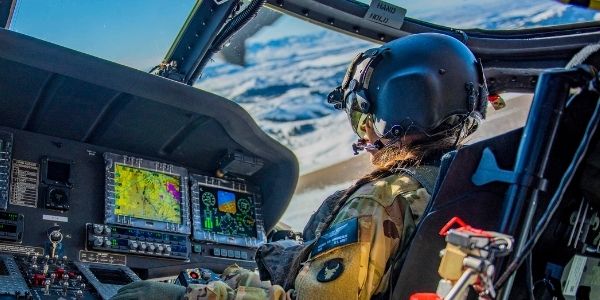
Branch Chief’s Corner / By MG David J. Francis:
The key component to the success of our military is the American Soldier. While modernization is an absolute imperative for our Army, it is the Soldier who is trained and ready to receive, use, and win with that new equipment that is essential. In the Aviation branch, our Soldiers fix, fly, and employ some of the most sophisticated aircraft in the world in support of the Ground Force Commander as a component of Combined Arms Maneuver. How we train, develop, and prepare our Soldiers, NCOs, Warrant Officers, and Officers is critical to provide our nation with an Army that can fight and win in Large Scale Combat Operations (LSCO).
 |
|
CW2 Oceana Chamberlain, 1-183rd Assault Helicopter Battalion, Idaho National Guard, practices flight maneuvers throughout Idaho’s snowy Owyhee Mountains, south of Gowen Field, on Jan. 13, 2022. |
The United States Army Aviation Center of Excellence (USAACE) is responsible for the training and Professional Military Education (PME) of our Aviation Soldiers from E-1 to O-8. USAACE leverages world-class instructors and facilities across three major installations to ensure we are providing the Army of 2030 a capable and ready force as a part of the joint fight. Institutional training is continuing to evolve at a rapid rate to match the improvements in doctrine, tactics, equipment, and increased knowledge and skills of our new Soldiers. Our redesigned education efforts are having immediate impacts on how we fight and train with our enduring airframes while setting the conditions to receive and employ our Future Vertical Lift (FVL) platforms. We are creating agile, flexible, adaptive leaders of character who possess the ability to think critically and timely.
Some of the largest changes and improvements to Aviation PME are occurring with our lieutenants and captains. The LTs and CPTs of today will serve as the company commanders, S3s, XOs, and battalion commanders of the Army that is expected to fight and win in LSCO. The Aviation Basic Officer Leadership Course provides new lieutenants with basic soldiering, leadership, officer skills and combined arms tactics in addition to the challenges of attending flight school. The culminating three week Aviation Leadership Exercise (ALE) allows the LTs to work with their WO1 counterparts on aviation mission planning, briefing, and execution of an actual aviation mission in a simulated environment. Our future leaders are better prepared to become valuable teammates capable of leading and executing aviation operations during their initial assignment.
The Aviation Captain’s Career Course (AVC3) is developing future company/troop commanders and staff officers at the battalion and brigade level who can also excel in LSCO. AVC3 is providing the CPTs with a crucial understanding of new and refined doctrine to ensure they understand how to fight on today’s battlefield while developing them to lead on the battlefield of the future.
All Aviation Battalion and Brigade Commanders attend the re-structured Aviation Pre-Command Course (PCC). PCC provides our CSL commanders an update on the latest Army Aviation Doctrine and Tactics, current trends and concerns across the enterprise, direct senior leader engagement and mentorship, and culminates in deliberate LSCO mission planning. This course does a phenomenal job of preparing our commanders for current operations while teaching them to think about future missions.
The future of how we fight and win our nation’s wars is changing rapidly. We will face a highly trained and highly capable enemy that is able to contest our forces in every domain. As our equipment modernizes and becomes more agile, lethal, and survivable our tactics and leadership development must modernize to maximize the capabilities of our new and legacy aircraft. The last 20 years of conflict taught us that the American Soldier is the key to victory, and it is essential that we provide the correct education to ensure they are prepared for the future fight. Every action we are taking in Army Aviation Branch is synchronized across the DOTLMPFP (doctrine, organization, training, materiel, leadership and education, personnel, facilities and policy) but the central focus is, and has to be, our Soldiers.
Newer, more adaptive and capable aircraft and digital systems are critical to our ability to fight and win. Highly trained, disciplined, physically and mentally fit Soldiers are WHY we win.
Above the Best!
– – – – –
MG David J. Francis is the Army Aviation branch chief and commander of the U.S. Army Aviation Center of Excellence and Fort Rucker, AL.










